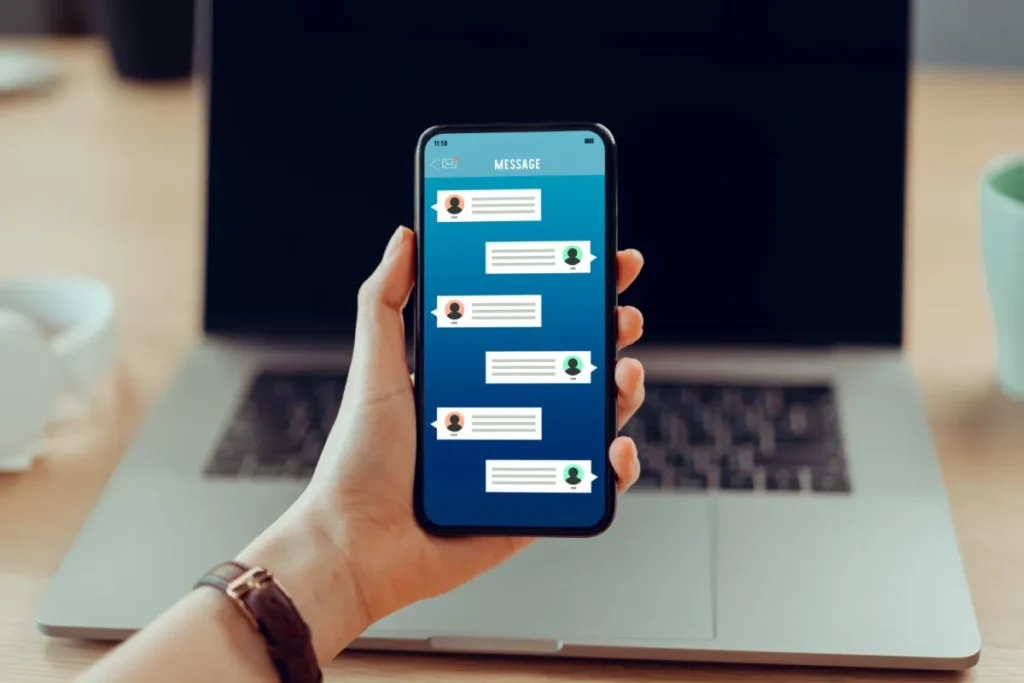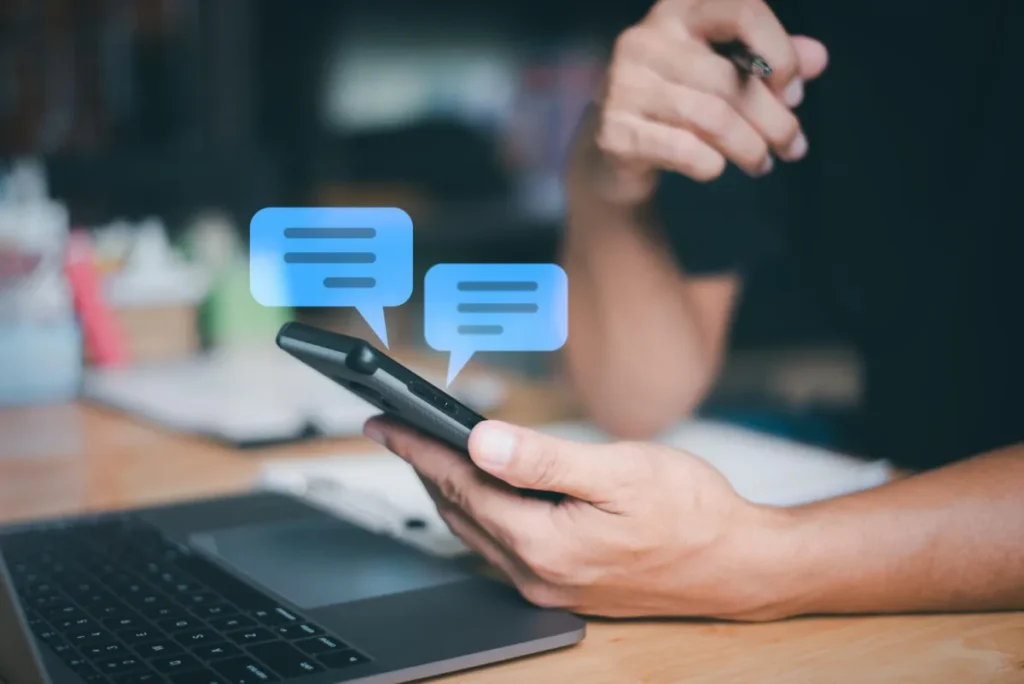In today’s fast-paced digital landscape, businesses need communication channels that can cut through the noise and reach customers instantly. SMS message marketing has emerged as one of the most powerful tools for direct customer engagement, offering unparalleled reach and response rates.
With over 5 billion people using mobile devices worldwide, SMS marketing provides businesses with a direct line to customers’ pockets, allowing for immediate connection regardless of location or time.
Unlike email or social media, SMS messages don’t require internet connectivity, making them accessible to virtually anyone with a mobile phone. This universal accessibility, combined with extraordinarily high open rates, makes SMS marketing an essential component of any comprehensive marketing strategy.
Let’s explore why SMS marketing is so effective and how you can implement it successfully for your business.
Why SMS Marketing Works

SMS marketing’s effectiveness stems from several key advantages that set it apart from other marketing channels. Understanding these benefits will help you leverage the full potential of text message marketing for your business.
High Open Rates
SMS messages boast an impressive 98% open rate, significantly outperforming email marketing’s average of 20%. This remarkable statistic means that almost every message you send will be seen by your audience. Unlike emails that might get buried in overflowing inboxes or social media posts that disappear in crowded feeds, text messages command immediate attention.
When a customer’s phone buzzes with a notification, there’s an inherent urgency to check the message. A study by Mobilesquared found that 90% of SMS messages are read within three minutes of delivery. This near-immediate engagement gives businesses a powerful opportunity to capture customer attention when it matters most.
For example, a local restaurant sending a lunchtime special promotion at 11:30 AM can drive immediate foot traffic, with customers responding to the timely offer within minutes of receiving it.
Instant Delivery
The real-time nature of SMS messaging makes it ideal for time-sensitive communications. Unlike other marketing channels that might experience delays, SMS messages are delivered instantly, allowing businesses to capitalize on urgency and prompt immediate action.
This instant delivery is particularly valuable for flash sales, limited-time offers, or event-based promotions. A retail store can announce a 24-hour sale and generate immediate traffic, both online and in-store. Similarly, event organizers can send last-minute reminders about upcoming events, boosting attendance rates.
A practical example comes from the travel industry, where airlines use SMS to send real-time flight updates. When delays occur, passengers receive instant notifications, improving customer experience by reducing uncertainty and allowing travelers to adjust their plans accordingly.
Cost-Effective
SMS marketing offers an excellent return on investment compared to traditional advertising channels. With an average cost between $0.01 and $0.05 per message when sent in bulk, businesses can reach thousands of customers for a fraction of what they would spend on print, television, or radio advertising.
This cost efficiency makes SMS marketing accessible to businesses of all sizes, from small local shops to large enterprises. Even with a modest budget, companies can implement effective SMS campaigns that drive significant results.
For instance, a small boutique clothing store might spend just $50 to send a promotional message to 1,000 loyal customers, potentially generating thousands in sales from a single campaign. With conversion rates often exceeding 30% for targeted SMS campaigns, the ROI consistently outperforms most other marketing channels.
High Engagement
SMS messages generate substantially higher engagement rates than other forms of digital marketing. The average response rate for SMS marketing campaigns is around 45%, compared to email’s 6% and social media’s even lower rates.
This high engagement stems from several factors: the personal nature of mobile phones, the brevity of text messages, and the direct communication style. When consumers receive a text message from a business, they perceive it as more personal and urgent than other marketing communications.
A fitness studio that sends personalized workout reminders or class notifications can see attendance rates increase by up to 40%. Similarly, an online retailer sending cart abandonment reminders via SMS can recover potentially lost sales with recovery rates as high as 20% – significantly outperforming email recovery campaigns.
As we’ve seen, SMS marketing offers unique advantages that make it an indispensable tool for modern businesses. Now, let’s explore how to build an effective SMS marketing list to maximize these benefits.
How to Build Your SMS Marketing List
![]()
Developing a robust SMS marketing list is the foundation of successful text message campaigns. Unlike email marketing where you might purchase lists (though not recommended), SMS marketing requires explicit opt-ins from consumers, making list-building a more deliberate process. Here’s how to grow your SMS subscriber base effectively and ethically.
Opt-In Forms
Creating seamless opt-in opportunities across your digital touchpoints is essential for building your SMS list. Your website should feature prominently displayed SMS subscription forms, strategically placed where they’ll capture visitor attention without disrupting the user experience.
Effective locations for SMS opt-in forms include:
- Homepage banners or floating widgets
- Checkout pages during the purchase process
- Account creation or registration forms
- Pop-ups for first-time visitors (with proper timing)
- Landing pages for specific promotions
Make sure your opt-in forms clearly communicate what subscribers can expect. Specify the types of messages they’ll receive (promotions, updates, alerts) and the frequency (weekly deals, monthly newsletters, etc.). Transparency builds trust and reduces unsubscribe rates.
For example, an e-commerce site might include a checkbox during checkout: “Text me exclusive offers (max 4 msgs/month)” with a link to terms and privacy policy. This clear communication sets proper expectations from the start.
Offering Incentives
Providing immediate value in exchange for phone numbers significantly increases opt-in rates. Consumers are more willing to share contact information when they receive something valuable in return. Effective incentives might include:
- Immediate discount codes (e.g., “Text JOIN to 12345 for 15% off your first order”)
- Free shipping on the next purchase
- Exclusive content or early access to new products
- Entry into a giveaway or contest
- Loyalty program enrollment with bonus points
A fashion retailer saw SMS list growth increase by 152% after implementing a “Text to get 20% off” campaign with in-store signage and website promotions. The immediate discount created urgency and tangible value for customers considering whether to opt in.
Remember to deliver the promised incentive immediately after signup to reinforce the value of subscription and start the relationship positively.
Promoting Through Multiple Channels
Cross-promoting your SMS program across all marketing channels creates multiple pathways for customers to join your list. Integrate SMS promotion into your existing marketing efforts:
- Email newsletters (with clear SMS benefits highlighted)
- Social media posts and profiles
- Physical signage in-store with keywords and short codes
- QR codes on packaging, receipts, and print materials
- Employee training to mention text options during customer interactions
- Direct mail campaigns with text-to-join instructions
Coffee chain Dutch Bros effectively promotes their text club through counter cards, drive-thru signage, and verbal mentions from baristas during transactions. Their multi-channel approach ensures customers encounter the SMS opt-in opportunity regardless of how they interact with the brand.
By implementing these list-building strategies consistently, you’ll develop a permission-based SMS marketing list of engaged subscribers. With a quality list established, the next step is understanding how to craft effective SMS campaigns that drive results.
Best Practices for SMS Marketing

Creating effective SMS marketing campaigns requires understanding the unique characteristics and constraints of the medium. Following these best practices will help you maximize engagement, maintain compliance, and achieve your marketing objectives.
Get Permission
The foundation of successful SMS marketing is obtaining explicit consent from recipients before sending messages. This isn’t just good practice—it’s legally required in most jurisdictions under regulations like the TCPA in the United States and GDPR in Europe.
Proper permission requires clear disclosure about:
- What types of messages you’ll send
- Approximate frequency of messages
- How to opt out at any time
- Any associated charges (e.g., “Msg & data rates may apply”)
Document when and how consent was obtained for each subscriber, including the specific language used in your opt-in forms. This creates a clear audit trail that protects your business in case of disputes.
For example, a subscription confirmation might read: “You’re subscribed to ABC Fitness alerts (3 msgs/month). Reply HELP for help, STOP to cancel. Msg&data rates may apply.” This covers all legal bases while setting clear expectations.
Keep Messages Short and Sweet
SMS messages have a 160-character limit for standard text, making brevity essential. Craft concise messages that deliver value immediately, without unnecessary words or fluff. Follow these guidelines:
- Lead with the most important information
- Use clear, simple language that’s easy to understand
- Include only one primary call to action per message
- Avoid industry jargon or complicated terminology
- Use abbreviations sparingly and only when widely understood
A well-crafted SMS might read: “FLASH SALE: 40% OFF all jackets today only! Use code WINTER40 online or in-store. Shop now: https://bit.ly/winter-sale” This message conveys the offer, timeframe, redemption instructions, and link in just 114 characters.
Remember that longer messages may be split into multiple texts, which can incur higher costs and potentially confuse recipients. When possible, keep messages within the 160-character limit.
Personalize Your Messages
Personalized SMS messages can increase response rates by over 40% compared to generic broadcasts. Use the customer data you’ve collected to tailor messages to individual preferences, behaviors, or demographics:
- Include the recipient’s first name
- Reference previous purchases or interactions
- Recommend products based on browsing or purchase history
- Send location-specific offers relevant to the customer’s area
- Acknowledge customer milestones like birthdays or anniversaries
A personalized message might read: “Hi Jordan! Your favorite Nike running shoes are back in stock in size 10. Want us to hold a pair? Reply YES and we’ll set them aside for 24 hours.”
This level of personalization demonstrates that you understand the customer’s preferences and are providing relevant, valuable information rather than generic marketing content.
Timing is Everything
The timing of your SMS messages significantly impacts their effectiveness. Sending messages at appropriate hours and optimal times increases engagement while reducing opt-out rates:
- Respect quiet hours (typically 9 PM to 9 AM in the recipient’s time zone)
- Consider the purpose of your message when selecting timing
- Test different send times to identify when your audience is most responsive
- Be mindful of time zones if your audience spans multiple regions
- Avoid sending messages on major holidays unless specifically relevant
Research shows that business-related SMS messages perform best during business hours, with particularly strong engagement during lunch breaks (12-1 PM) and early evening (5-6 PM) when people check their phones more frequently.
For time-sensitive promotions, a restaurant sending lunch special announcements at 11 AM sees significantly higher redemption rates than those sent at 9 AM or 1 PM, when the offer is either too early to consider or too late to act upon.
Include a Clear Call to Action
Every marketing SMS should include a specific, clear call to action that guides recipients on what to do next. Without a CTA, even well-crafted messages may fail to generate results:
- Use action-oriented language (“Shop,” “Register,” “Claim,” “Reply”)
- Create urgency when appropriate (“Today only,” “Limited time”)
- Keep CTAs simple and easy to complete on mobile devices
- Include shortened URLs for online actions
- Specify exactly how to redeem offers (codes, showing the text, etc.)
An effective CTA might read: “Show this text for BOGO appetizers today at Joe’s Grill. Valid until 7PM. No purchase necessary.” This tells recipients exactly what they get, how to get it, and when the offer expires.
For online redemptions, always use shortened URLs that are trackable, allowing you to measure click-through rates and attribute conversions to specific campaigns.
With these best practices in mind, you can create SMS campaigns that respect consumer preferences, deliver value, and drive measurable results. Next, let’s examine the legal requirements for SMS marketing to ensure your campaigns remain compliant.
SMS Marketing Compliance

Navigating the complex regulatory landscape of SMS marketing is crucial for sustainable success. Non-compliance can result in significant penalties, damage to brand reputation, and loss of customer trust. Understanding and adhering to SMS marketing regulations protects both your business and your customers.
Understanding Regulations
SMS marketing is governed by several regulations that vary by country and region. In the United States, the primary frameworks include:
- Telephone Consumer Protection Act (TCPA): Requires explicit written consent before sending marketing messages
- CAN-SPAM Act: Governs commercial messaging, including identification requirements
- CTIA Guidelines: Industry standards for messaging best practices
- State-specific laws: Such as the California Consumer Privacy Act (CCPA)
Internationally, regulations like the General Data Protection Regulation (GDPR) in Europe impose additional requirements for obtaining and managing consent.
Key compliance requirements typically include:
- Obtaining explicit consent before sending messages
- Clearly identifying your business in each message
- Providing simple opt-out mechanisms
- Honoring opt-out requests immediately
- Sending only during permitted hours
- Maintaining records of consent
For example, under TCPA, businesses face fines of $500-$1,500 per violation (per text sent without proper consent). In 2020, Jiffy Lube settled a TCPA lawsuit for $47 million after allegedly sending promotional texts to consumers without proper consent, highlighting the significant financial risk of non-compliance.
Obtaining Consent
Proper consent collection is the cornerstone of compliant SMS marketing. Consent must be express, informed, and documented:
- Express: Recipients must take affirmative action to opt in (checking an unchecked box, texting a keyword, etc.)
- Informed: Clear disclosure of message frequency, content type, and potential charges
- Documented: Records of when, how, and what the consumer consented to
Acceptable consent collection methods include:
- Keyword texting (e.g., “Text JOIN to 12345”)
- Web forms with clear SMS opt-in language
- Paper forms with signature
- Verbal consent with proper documentation
A compliant web form might include checkbox language stating: “I agree to receive recurring automated marketing messages from ABC Company at the phone number provided. Consent is not a condition of purchase. Msg frequency varies. Msg & data rates may apply. Reply HELP for help and STOP to cancel.”
Always maintain records of:
- Date and time of opt-in
- Source of opt-in (website, in-store, event)
- Specific language used in the opt-in disclosure
- IP address for digital opt-ins
- Keyword used (for text-to-join campaigns)
Providing Opt-Out Options
Making it easy for recipients to opt out of future messages is not just a legal requirement—it’s a best practice that respects consumer choice and builds trust:
- Include opt-out instructions in every message (e.g., “Reply STOP to unsubscribe”)
- Process opt-out requests immediately (within 10 business days is required, but immediate is best practice)
- Confirm opt-outs with a single message acknowledging the request
- Never charge for opt-out messages
- Train staff to handle verbal opt-out requests
- Honor opt-outs across all messaging programs from your organization
After receiving an opt-out request, send a simple confirmation like: “You’ve been unsubscribed from ABC Company alerts. No more messages will be sent.” This provides closure to the customer and confirms their request was processed.
Maintain an updated suppression list of opted-out numbers, and cross-check all marketing lists against this database before campaigns to prevent accidental messaging to those who have opted out.
Compliance might seem overwhelming, but with proper systems and documentation in place, it becomes a routine aspect of SMS marketing. By respecting regulations and consumer choice, you build a foundation for sustainable, effective text message marketing.
Now that we understand the rules governing SMS marketing, let’s explore real-world examples of successful campaigns that have driven measurable results for businesses.
Examples of Effective SMS Marketing Campaigns

Examining successful SMS marketing campaigns provides valuable insights into effective strategies and tactics. These real-world examples demonstrate how businesses across various industries have leveraged text message marketing to achieve specific business objectives.
Retail Promotions
Retail businesses have found remarkable success with SMS marketing for driving both online and in-store traffic through timely promotions:
Starbucks regularly sends personalized offers based on previous purchase behavior, achieving conversion rates up to 34% through SMS. Their “Happy Hour” text alerts deliver time-sensitive offers (like “BOGO drinks from 2-6 PM today”) that create urgency and immediate store visits.
Fashion retailer Urban Outfitters implements multi-stage SMS campaigns around major shopping events. For Black Friday, they send a teaser message three days before, a reminder the night before with exclusive preview offers, and then lightning deals throughout the day. This strategy generated a 25% increase in same-day sales compared to email-only promotions.
Key success factors for retail SMS campaigns include:
- Clear value proposition (specific discount or offer)
- Sense of urgency or exclusivity
- Simple redemption process (show phone, code, or link)
- Personalization based on purchase history
- Strategic timing before peak shopping hours
A small boutique store increased weekend traffic by 37% using a simple Friday message: “Weekend Flash Sale! Show this text for 25% off any item. Valid Sat-Sun only at Main St location.”
Appointment Reminders
Service-based businesses use SMS to reduce no-shows and improve operational efficiency:
Healthcare providers implementing SMS appointment reminders have seen no-show rates decrease by 25-50%. A dental practice found that sending a reminder 24 hours before appointments with an option to confirm or reschedule reduced missed appointments by 43%, saving an estimated $15,000 monthly in lost revenue.
Salons and spas use two-way SMS communication for appointment management. When a client texts to reschedule, staff can immediately offer alternative slots, maintaining booking density and revenue. One hair salon implemented this system and filled 78% of potentially canceled appointments through immediate text-based rebooking.
Effective appointment reminder texts include:
- Specific date, time, and location information
- Provider or service details
- Simple confirmation request (“Reply YES to confirm”)
- Clear rescheduling instructions
- Preparation instructions when applicable
An auto service center’s effective reminder: “Hi John, reminder: your oil change appointment is tomorrow (5/12) at 2 PM with Mike at Jiffy Lube on Main St. Reply C to confirm or R to reschedule. Please arrive 10 min early.”
Event Invitations
Event marketers leverage SMS to boost attendance and engagement before, during, and after events:
Conference organizers using SMS for event communications report attendance increases of up to 30%. One technology conference sent a series of messages counting down to the event, including logistical updates, speaker highlights, and networking opportunities. The day-of SMS open rate was 98%, compared to email’s 23%, ensuring critical information reached attendees.
Music venues employ SMS for last-minute ticket sales, filling an average of 37% more unsold seats when sending targeted texts to previous attendees within a 30-mile radius. One venue sold out a concert that was only at 60% capacity 24 hours before by sending a limited-time discount code via text.
Successful event SMS strategies include:
- Early-bird registration incentives
- Countdown reminders with excitement-building content
- Day-of logistics and updates
- Real-time schedule changes or special announcements
- Post-event surveys and feedback requests
A charity gala increased donations by sending SMS updates during the event: “We’re at $45,000 toward our $75,000 goal! Text DONATE20 to give $20 and help us reach our target tonight!”
Customer Support
Innovative businesses are integrating SMS into their customer support ecosystem, improving satisfaction and resolution times:
E-commerce companies offering text-based support resolve issues 31% faster than email and with higher customer satisfaction. One online retailer implementing SMS support saw resolution time drop from an average of 4.2 hours to 25 minutes, with 94% of customers rating the experience as “excellent” compared to 71% for email support.
Airlines use SMS for disruption management, allowing passengers to rebook or request assistance via text during delays or cancellations. This approach reduced call center volume by 23% during weather events and improved customer satisfaction scores by 18% during travel disruptions.
Effective customer support via SMS includes:
- Immediate acknowledgment of the issue
- Clear timeframe for resolution
- Personalized, conversational responses
- Seamless handoff to specialized support when needed
- Follow-up to ensure satisfaction
A hotel chain’s support text demonstrates best practices: “Hi Emma, we’re sorry about the WiFi issues in your room. Our tech is on the way and will arrive within 15 minutes. Text us if you need anything else during your stay.”
These examples illustrate the versatility and effectiveness of SMS marketing across different business objectives and industries. Next, we’ll explore how to measure the success of your SMS campaigns to ensure you’re achieving optimal results.
Measuring the Success of Your SMS Marketing Campaign

Without proper measurement, it’s impossible to determine the true impact of your SMS marketing efforts. Establishing the right metrics and analysis framework allows you to optimize campaigns, justify investment, and continuously improve results.
Key Metrics to Track
Effective measurement begins with tracking the right performance indicators. These core metrics provide insight into different aspects of campaign performance:
Delivery Rates: The percentage of messages successfully delivered to recipients’ phones. Industry benchmarks suggest aim for delivery rates above 97%. Lower rates may indicate list quality issues or carrier filtering problems.
Open Rates: While traditional SMS doesn’t provide open tracking, read receipts are available through some advanced platforms and rich messaging formats like RCS. For standard SMS, assume a 98% open rate based on industry research.
Click-Through Rates (CTR): The percentage of recipients who click on links within your messages. Average SMS CTR ranges from 10-30%, significantly higher than email (3-5%). Tracking requires using shortened URLs with tracking parameters.
Conversion Rates: The percentage of recipients who complete desired actions after receiving your text. Depending on your objectives, this might be purchases, form completions, appointment bookings, or other goals. Average SMS conversion rates range from 10-15% for retail offers.
Opt-Out Rates: The percentage of recipients who unsubscribe after each campaign. Healthy campaigns maintain opt-out rates below 3% per message. Higher rates indicate potential issues with messaging frequency, relevance, or value proposition.
Response Rates: For two-way SMS campaigns, track how many recipients reply to your messages. Average response rates range from 20-45% for messages with clear response requests.
ROI/Revenue Generated: The ultimate measure of campaign success is financial return. Calculate this by tracking purchases or value directly attributed to SMS campaigns compared to campaign costs.
A retail business might track: “Our flash sale SMS generated 342 store visits (tracked through unique coupon redemptions), resulting in $8,760 in incremental sales from a campaign costing $320, yielding a 27:1 ROI.”
Analyzing Results
Collecting data is only the first step—proper analysis transforms raw numbers into actionable insights:
Segmentation Analysis: Compare performance across different customer segments to identify which groups respond best to SMS marketing. Segments might include demographics, purchase history, geographic location, or opt-in source.
Message Element Testing: Analyze which message components drive the strongest results:
- Does including the customer’s name increase conversion?
- Do questions perform better than statements?
- Which call-to-action phrases generate the highest click rates?
- Does message length correlate with response rates?
Timing Impact Assessment: Examine how send time affects performance by analyzing:
- Day of week patterns
- Time of day variations
- Relationship to external events (payday, holidays, weather)
- Time between messages in a sequence
Campaign Comparison: Compare SMS performance against other marketing channels (email, social media, paid ads) to determine relative effectiveness and appropriate budget allocation.
A comprehensive analysis might reveal: “Tuesday messages outperform Saturday messages by 24% in click-through rate, while personalized texts mentioning previous purchases convert 37% better than generic promotional messages. Morning texts (9-11 AM) generate the highest ROI for our audience.”
Adjusting Strategies
The true value of measurement comes from using insights to refine your approach and improve results over time:
Content Optimization: Use performance data to refine message content:
- Double down on message formats with above-average engagement
- Test variations of high-performing messages to further improve results
- Eliminate underperforming approaches
- Incorporate successful elements across campaigns
Frequency Calibration: Analyze opt-out rates in relation to messaging frequency to find the optimal balance. Too many messages lead to opt-outs, while too few miss engagement opportunities.
Segment Refinement: Create more targeted segments based on response patterns, allowing for greater personalization and relevance in future campaigns.
Automation Triggers: Adjust the timing and conditions of automated SMS sequences based on when customers are most responsive.
Budget Reallocation: Shift resources toward the highest-performing SMS campaigns and away from underperforming initiatives.
A business implementing these adjustments might report: “After analyzing six months of campaign data, we reduced our general broadcast messages by 30% and increased triggered behavioral messages by 50%. This adjustment decreased opt-outs by 22% while increasing overall revenue per message by 34%.”
With a solid measurement framework in place, you can continually refine your SMS marketing strategy for maximum effectiveness. Next, let’s explore how SMS can work in conjunction with other marketing channels for a cohesive omnichannel approach.
Integrating SMS Marketing with Other Channels

SMS marketing reaches its full potential when integrated strategically with other marketing channels. This omnichannel approach creates seamless customer experiences, reinforces messaging across touchpoints, and leverages the unique strengths of each channel.
Email Marketing
Email and SMS complement each other perfectly, combining email’s rich content capabilities with the immediacy and high open rates of text messaging:
Coordinated Campaigns: Use both channels in tandem, with emails providing detailed information and SMS delivering time-sensitive reminders or alerts. For instance, send a comprehensive email about an upcoming sale, followed by an SMS reminder when the sale begins.
Channel Preferences: Allow customers to choose their preferred communication channel for different types of messages. Some may want order confirmations via email but shipping updates via SMS.
Sequential Messaging: Implement automated sequences that move between channels based on engagement. If a customer doesn’t open an abandoned cart email within 24 hours, follow up with an SMS reminder.
Cross-Promotion: Use each channel to grow the other – include SMS opt-in opportunities in email footers and promote email newsletter benefits in text messages.
A travel company effectively combines these channels: They send detailed itineraries and travel guides via email before a customer’s trip, then use SMS for real-time updates during travel. This approach saw customer satisfaction scores increase by 28% compared to single-channel communication.
Implementation Tip: Ensure consistent messaging and branding across both channels while adapting content format to suit each medium’s strengths and limitations.
Social Media
SMS and social media marketing create powerful synergies when properly integrated:
Event Amplification: Use SMS to drive immediate action during social media events like live streams, product launches, or Q&A sessions. A fashion brand texting “Our Instagram Live with designer Sarah James starts in 15 minutes! Join now for exclusive discount codes” saw 34% higher viewership than social-only promotion.
Contest and UGC Promotion: Send text messages encouraging participation in social media contests or user-generated content campaigns. This creates a direct push notification effect for social initiatives.
Exclusive Content: Offer SMS subscribers early or exclusive access to content that will later be shared on social platforms, creating value for text opt-ins.
Crisis Management: During social media service outages or algorithm changes, SMS provides a reliable direct channel to maintain customer communication.
A restaurant chain uses this approach effectively: They promote weekly specials on Instagram with visually appealing photos, then send SMS messages during peak hunger hours (11 AM and 5 PM) with a direct ordering link. This coordinated strategy increased online orders by 42% compared to social-only promotion.
Implementation Tip: Use unique tracking links or codes in SMS messages promoting social content to measure cross-channel movement and attribution.
Push Notifications
Mobile app push notifications and SMS can work together strategically, each serving different communication needs:
Hierarchical Urgency: Use push notifications for lower-priority updates and SMS for critical, time-sensitive information. This creates a natural urgency hierarchy that customers quickly understand.
Fallback Communication: Implement SMS as a fallback when push notifications fail to deliver due to opt-out or technical issues. This ensures important messages always reach customers.
On-Boarding Flows: Use SMS to encourage app downloads and feature adoption, then transition to push notifications for ongoing engagement once the customer is active in the app.
Re-Engagement: When users become inactive in your app, SMS can provide a powerful external trigger to bring them back into the ecosystem.
A banking app employs this strategy effectively: They use push notifications for standard account updates and balance alerts, but automatically switch to SMS for security alerts, possible fraud warnings, and critical account notices. This system ensures 99.7% delivery of high-priority messages compared to 84% with push-only.
Implementation Tip: Clearly communicate to customers which types of messages will come through each channel to set appropriate expectations and prevent communication fatigue.
By thoughtfully integrating SMS with these complementary channels, you create a cohesive communication ecosystem that meets customers where they are while respecting their preferences and behaviors. The next critical step is selecting the right SMS marketing platform to execute your strategy effectively.
Choosing the Right SMS Marketing Platform

The SMS marketing platform you select will significantly impact your campaign capabilities, compliance management, and overall results. With numerous options available, understanding key features and requirements helps you make an informed decision aligned with your business needs.
Features to Look For
When evaluating SMS marketing platforms, prioritize these essential capabilities:
Compliance Tools: Look for built-in compliance features that help you adhere to regulations:
- Automated opt-out processing
- Consent tracking and documentation
- Pre-approved compliant message templates
- Time zone awareness to prevent after-hours messaging
- SHAFT content filtering (Sex, Hate, Alcohol, Firearms, Tobacco)
Two-Way Messaging: The ability to receive and automatically process responses enables interactive campaigns, customer service via text, and more sophisticated automation.
Segmentation Capabilities: Advanced segmentation allows for targeted messaging based on customer attributes, behaviors, and preferences:
- Demographic segmentation
- Purchase history categorization
- Engagement-based grouping
- Location-based targeting
- Custom field filtering
Automation and Triggers: Look for robust workflow capabilities:
- Drip campaigns and sequences
- Behavior-triggered messages
- Date-based automations (birthdays, anniversaries)
- Abandoned cart recovery
- Post-purchase follow-ups
Analytics and Reporting: Comprehensive reporting features help you measure performance and optimize campaigns:
- Delivery and response tracking
- Link click attribution
- Conversion tracking
- A/B testing capabilities
- ROI calculation
Integration Capabilities: The platform should connect seamlessly with your existing tech stack:
- CRM systems
- E-commerce platforms
- Email marketing software
- Customer support tools
- POS systems
Scalability: Ensure the platform can grow with your business:
- Flexible pricing models
- High-volume sending capabilities
- Multiple user accounts with permission levels
- API access for custom integrations
A medium-sized e-commerce business might prioritize: “We needed a platform with Shopify integration, advanced cart abandonment automation, and detailed conversion tracking. These features allowed us to recover $42,000 in otherwise lost sales in the first quarter after implementation.”
Top SMS Marketing Platforms
While needs vary by business, these leading platforms offer robust features suitable for different requirements:
DailyStory: An all-in-one marketing platform with powerful SMS capabilities, automation, and integration with popular CRM systems. Particularly strong for businesses looking to combine email and SMS in cohesive campaigns. Offers unlimited users, unlimited campaigns, and segmentation capabilities on all plans.
Twilio: Developer-focused solution offering exceptional customization through its API. Ideal for businesses with technical resources seeking to build custom SMS applications or deeply integrate texting into existing systems.
EZ Texting: User-friendly platform with intuitive campaign management tools. Excellent for small-to-medium businesses and organizations seeking simplicity without sacrificing essential features.
Attentive: Specialized in e-commerce SMS marketing with advanced features for personalization and product recommendations. Includes innovative list growth tools specifically designed for online retailers.
SimpleTexting: Balanced platform offering ease of use and advanced features. Provides two-way messaging, dedicated short codes, and a robust API for custom integrations.
When selecting a platform, prioritize:
- Alignment with your specific use cases
- User interface simplicity and team adoption
- Quality of customer support
- Scalability as your SMS program grows
- Total cost including overage fees and add-ons
A retail business found their match: “After testing three platforms, we selected DailyStory because their Shopify integration was seamless, and their automation builder allowed our marketing team to create sophisticated workflows without developer assistance. Their analytics directly tied SMS campaigns to in-store and online purchases, giving us clear ROI visibility.”
The right platform serves as the foundation for your SMS marketing success, enabling efficient execution of campaigns while maintaining compliance and measuring performance. As we conclude, let’s examine what the future holds for SMS marketing and how you can get started immediately.
Conclusion
SMS marketing has established itself as an essential component of the modern marketing mix, offering unparalleled reach, engagement, and ROI. As we’ve explored throughout this guide, text message marketing provides direct access to customers’ most personal devices, creating opportunities for meaningful connections and immediate action.
Frequently Asked Questions
What is the difference between SMS and MMS marketing?
SMS (Short Message Service) marketing uses text-only messages limited to 160 characters, while MMS (Multimedia Messaging Service) allows the inclusion of media elements like images, short videos, and GIFs. MMS messages typically cost more to send but can achieve higher engagement through visual elements. SMS offers universal compatibility across all mobile phones, while MMS may not be supported by some older devices or certain mobile plans.
How much does SMS marketing cost?
SMS marketing costs vary based on volume, platform, and whether you use shared or dedicated short codes. Typical pricing ranges from $0.01 to $0.05 per message for high-volume sending. Additional costs may include platform subscription fees ($20-$1,000+ monthly depending on features), short code leasing ($500-$1,000 monthly for dedicated codes), and initial setup fees. Many providers offer tiered pricing with volume discounts for larger sending requirements.
How can I grow my SMS subscriber list quickly?
To accelerate SMS list growth, implement multiple opt-in points including website popups, checkout opportunities, and in-store signage. Offer compelling, immediate incentives for subscribing such as discounts or exclusive content. Promote your SMS program across all marketing channels, especially to your existing email subscribers. Consider running dedicated acquisition campaigns with clear value propositions. Always prioritize quality over quantity, as engaged subscribers generate significantly more value than unengaged contacts.
What’s the ideal frequency for sending SMS marketing messages?
The optimal frequency varies by industry and audience, but research suggests 2-4 messages per month is appropriate for most retail and service businesses. Restaurants and entertainment venues may send 4-6 messages monthly. Always set clear expectations during the opt-in process about message frequency, and monitor opt-out rates after campaigns to identify possible frequency fatigue. Some businesses successfully implement tiered frequency options, allowing subscribers to select their preferred volume of communications.
How can I measure the ROI of SMS marketing?
Measure SMS marketing ROI by tracking direct conversions from text campaigns through unique promo codes, dedicated landing pages, or “show this text” in-store redemptions. Calculate ROI by dividing the profit generated by campaign costs. Example: If your campaign costs $300 to send and generates $1,500 in profit from attributable sales, your ROI is 5x (or 500%). Compare this to other marketing channels to demonstrate SMS effectiveness. More sophisticated measurement might incorporate customer lifetime value increases among SMS subscribers versus non-subscribers.
SMS marketing has established itself as an essential component of the modern marketing mix, offering unparalleled reach, engagement, and ROI. As we’ve explored throughout this guide, text message marketing provides direct access to customers’ most personal devices, creating opportunities for meaningful connections and immediate action.
The Future of SMS Marketing
SMS marketing continues to evolve, with several emerging trends shaping its future:
Rich Communication Services (RCS): The next generation of SMS, RCS enables rich media, interactive elements, and enhanced analytics within the native messaging app. This technology combines the universal reach of SMS with the interactive capabilities of messaging apps. Businesses adopting RCS early are seeing engagement increases of 35-40% compared to standard SMS.
Conversational AI Integration: SMS platforms increasingly incorporate AI capabilities, enabling natural language processing, intelligent response handling, and personalization at scale. This allows even small businesses to provide 24/7 text-based support and engagement without expanding staff.
Enhanced Personalization: Advanced data integration is enabling hyper-personalized SMS experiences based on real-time customer behaviors, preferences, and context. Messages that dynamically adapt content based on individual customer profiles are showing conversion improvements of 25-30% over standard segmented campaigns.
Cross-Channel Attribution: As measurement sophistication increases, businesses can better understand how SMS influences and is influenced by other marketing channels. This holistic view optimizes overall marketing spend and strategy.
Privacy-First Approaches: With increasing privacy regulations worldwide, successful SMS marketers are embracing transparent consent practices and value-based messaging that respect customer preferences while still driving results. Brands prioritizing privacy as a feature rather than a compliance burden are seeing higher opt-in rates and customer loyalty.
As consumers grow increasingly comfortable with mobile transactions, SMS will continue to evolve as a critical touchpoint in the customer journey, particularly for time-sensitive communications and immediate conversion opportunities. Organizations that invest in SMS capabilities now will build valuable direct channels to customers that become increasingly valuable as third-party data sources become more restricted.

